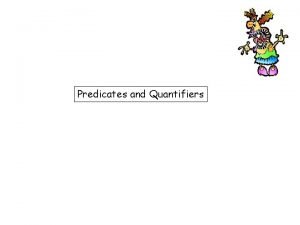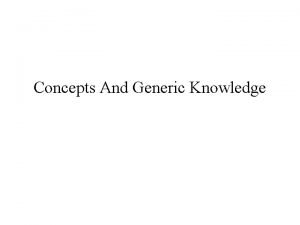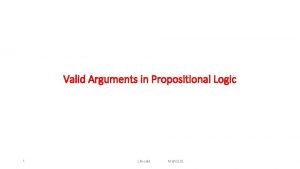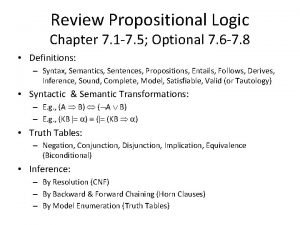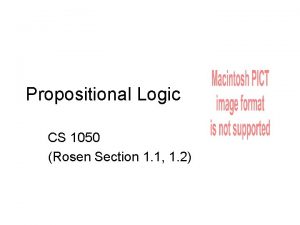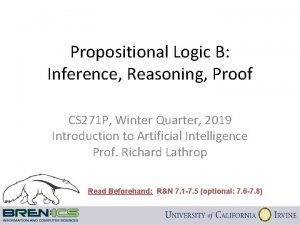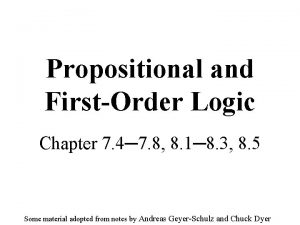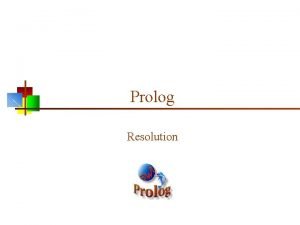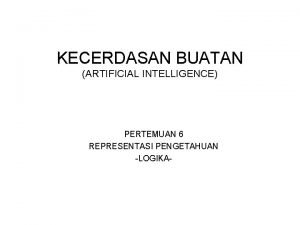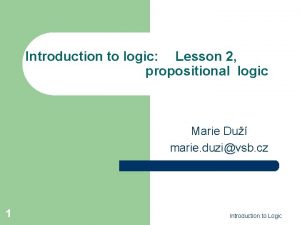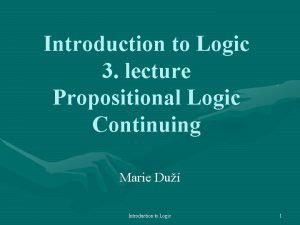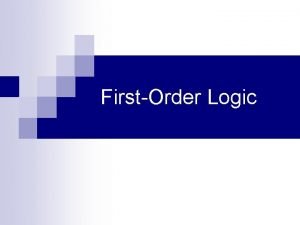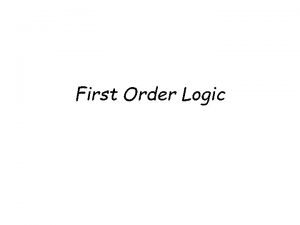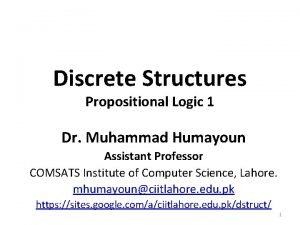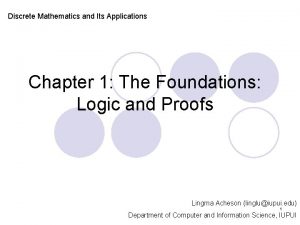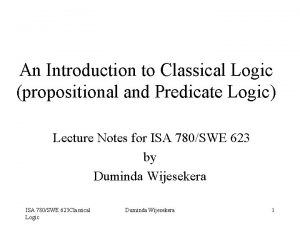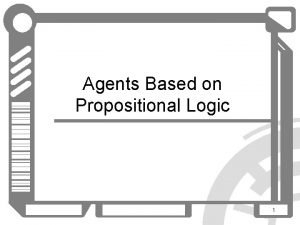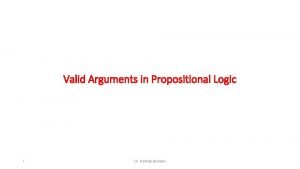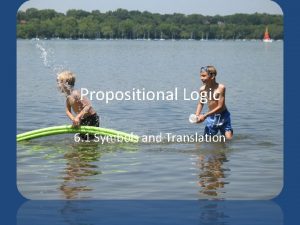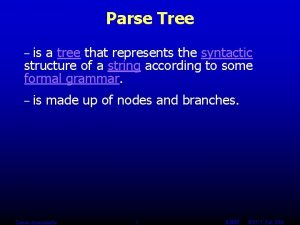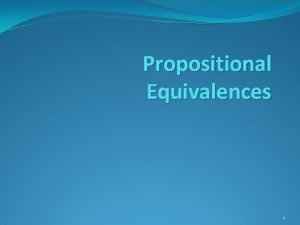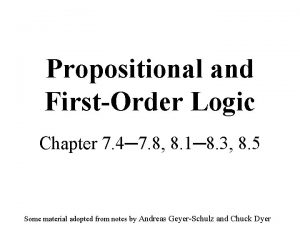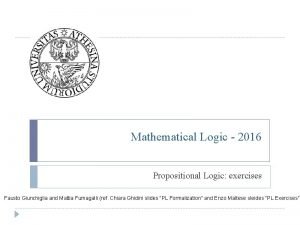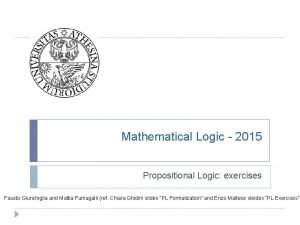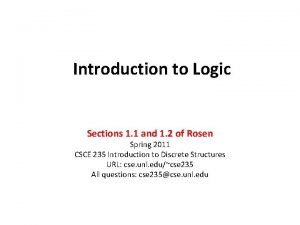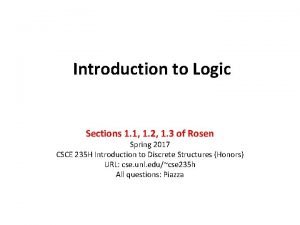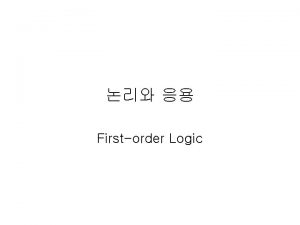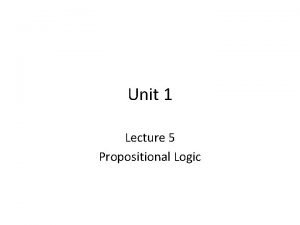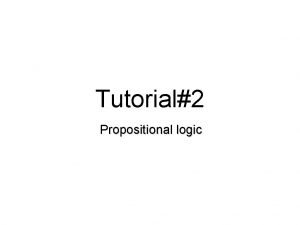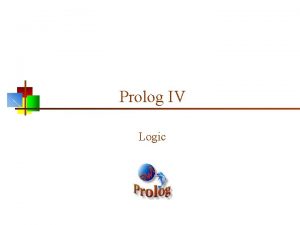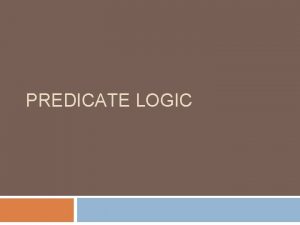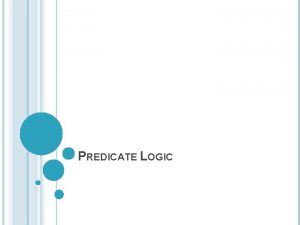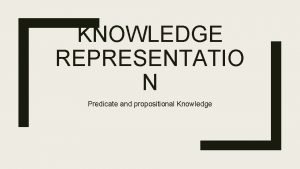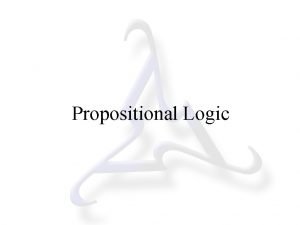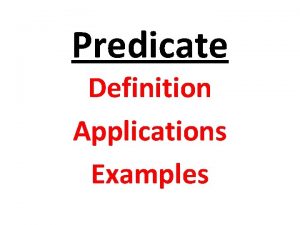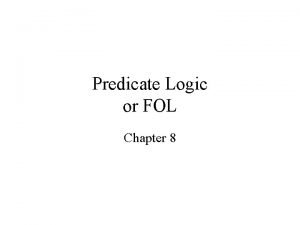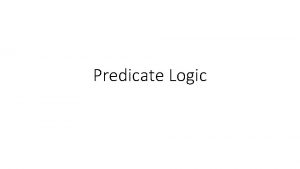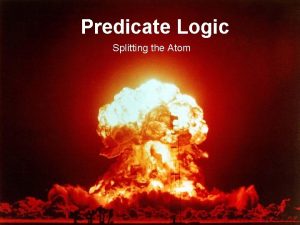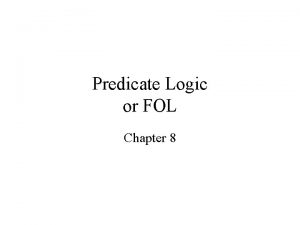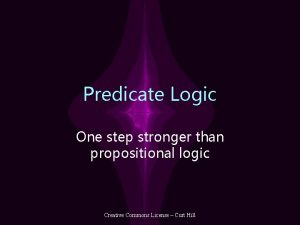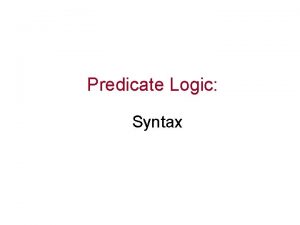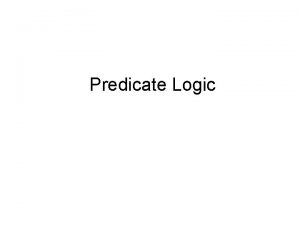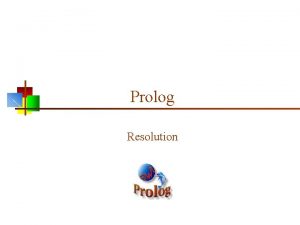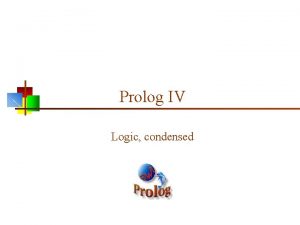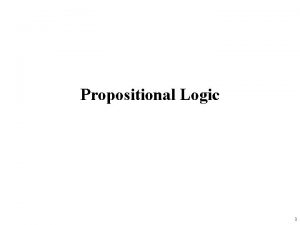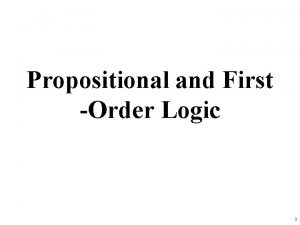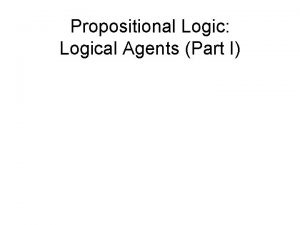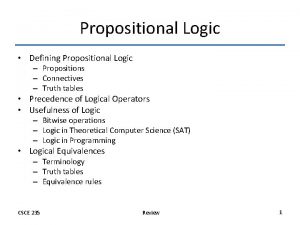Logic for knowledge representation Points Propositional logic Predicate




































- Slides: 36

Logic for knowledge representation Points Propositional logic Predicate logic • The pros and cons • Syntax • Semantics Inference • Soundness and completeness The clausal form • The conversion procedure Resolution Control of reasoning CSI 4106, Winter 2005 Logic, page 1

Propositional logic We need to represent properties of objects in the world we model, and relations between objects. Propositional logic is not expressive enough. It allows no generality and no generalization: just try to express the fact “dogs have tails”. This is the simplest form of logic. It has only one advantage: there is an effective procedure for proving theorems in it. That is, propositional logic is decidable. CSI 4106, Winter 2005 Logic, page 2

Predicate logic First-order predicate logic gives us much of what we need; its various extensions offer a wide spectrum of knowledge representation possibilities. Predicate logic has a few obvious advantages: • it has been known and applied in practice for some 2500 years; • it has well-defined reasoning methods; • it is based on a solid theory that gives us “for free” the semantics of this knowledge representation method. CSI 4106, Winter 2005 Logic, page 3

Predicate logic (2) There also are drawbacks of predicate logic: • it offers no support for hierarchical organization (e. g. , no object orientation); • it is absolute (“frozen in time”) -- there are problems with representing typical situations and objects, and expressing defaults; • it does not allow common-sense reasoning or approximate reasoning; • it has only undecidable or semidecidable proof procedures (but this is true of other representation methods). CSI 4106, Winter 2005 Logic, page 4

Predicate logic syntax -- a refresher A very brief review the syntax (in a Prolog-style notation). In an atom, the predicate denotes the general nature of things, while the arguments (terms) represent the details. Example: on. Market(house(address(ottawa, main, 10), bedrooms(4)), price(225000)) Variables allow us to generalize, for example: on. Market(house(A, B), price(P)) CSI 4106, Winter 2005 Logic, page 5

. . . syntax -- a refresher (2) The logical connectives , , produce formulae out of formulae. Quantifiers allow us to make general statements about classes of individuals: A N ( on. Market(house(A, bedrooms(4)), price(N)) N < 190000 make. Offer. For(A) ) CSI 4106, Winter 2005 Logic, page 6

First order? “First order” means that we can only reason about sets of individuals, that is, only individuals can be quantified. Predicates are fixed. In higher-order logics variables are allowed in predicate positions. Two examples: X Y X(Y) “each property has at least one instance” X (X(a) X(b)) “a and b have the same properties” CSI 4106, Winter 2005 Logic, page 7

Predicate logic semantics Quantifiers, logical connectives, atoms (predicates, arguments), terms (functors, constants, variables) are the syntactic elements of first-order logic. They must be given a semantic interpretation if we want them to represent the world. Formally, the term address(ottawa, main, 10) need not represent a house. The symbols address, ottawa, main could denote anything. CSI 4106, Winter 2005 Logic, page 8

Predicate logic semantics (2) We interpret logical formulae by mapping their elements into a domain. A term without variables corresponds to an object in the domain. An atom without variables corresponds to a true or false statement about domain objects. For example: ottawa corresponds to the city of Ottawa, main corresponds to Main Street in Ottawa, address(ottawa, main, 10) corresponds to a valid Ottawa address, on. Market(house(address(ottawa, main, 10), bedrooms(4)), price(225000)) denotes a true or false statement about a specific house. CSI 4106, Winter 2005 Logic, page 9

Predicate logic semantics (3) Let S be a set of logical formulae that represent an AI problem. Atoms in S correspond to true or false statements about the problem. A model of S is any subset of atoms -- all those that we consider true. All atoms not in the model are by definition false. A formula with logical connectives has its truth value derived from the values of its components. For example, S 1 S 2 is true if both S 1 and S 2 are in the model. (This is a hugely simplified approach to models in logic. ) CSI 4106, Winter 2005 Logic, page 10

Predicate logic semantics (4) A tautology is something that is true in every model. A classic example is this formula true for any H, P: on. Market(H, P) Two formulae are model-equivalent if, in every model, they are either both true or both false. Formula Φ entails formula Ψ if Ψ is true in every model in which Φ is true. This is written as: Φ |= Ψ For example, (on. Market(H, P) sold(H)) sold(H) |= on. Market(H, P) CSI 4106, Winter 2005 Logic, page 11

Inference Entailment allows us to represent certain aspects of rational behaviour: a logically thinking agent draws conclusions from facts, and so in some way derives new knowledge. We need a procedure that will implement this kind of logical thinking. Inference is such a procedure, especially if it has two important properties: it derives only good knowledge; it derives all knowledge that can be derived. CSI 4106, Winter 2005 Logic, page 12

Inference rules 1. Tableaux-based methods. (Try to construct a model that makes a given formula Φ false. If we cannot construct any such model, we have proven Φ. ) 2. The resolution rule (much more about it soon). 3. Natural deduction. Rule Given 1 Given 2 Inferred modus ponens modus tollens negation (1) negation (2) CSI 4106, Winter 2005 Logic, page 13

Inference rules (2) Rule Given 1 Given 2 Inferred conjunction introduced conjunction eliminated disjunction introduced disjunction eliminated proof of from Rule Given Inferred proof of from assuming proof by contradiction proof of from assuming conditional proof CSI 4106, Winter 2005 Logic, page 14

Good knowledge, all knowledge The notation Φ |- Ψmeans: “we can infer Ψ from Φ”. An inference rule is sound if an inferred formula is also entailed: If Φ |- Ψ then Φ |= Ψ An inference rule is complete if every entailed formula can be inferred: If Φ |= Ψ then Φ |- Ψ We can say that, for every Φ and Ψ, a sound and complete inference rule ensures: Φ |- Ψ if and only if Φ |= Ψ or, even more neatly: CSI 4106, Winter 2005 Logic, page 15

Resolution We begin with an advertisement. . . The resolution proof procedure is attractive: one inference rule plus unification (to be explained soon). The resolution proof procedure is practical: Prolog is based on resolution (meta-interpretation helps enrich the procedure with explanations). Downside: the clausal form, required by resolution, is less natural than full first-order logic (but intuitive!), and the proof procedure is still costly unless we restrict the form of clauses. CSI 4106, Winter 2005 Logic, page 16

The clausal form Resolution (2) A literal is either an atom, or a negated atom. A clause is a disjunction of literals: A 1 A 2 . . . An ¬B 1 ¬B 2 . . . ¬Bm In Prolog, only Horn clauses are allowed. A Horn clause has at most one positive literal. For example, the following Prolog clause a(X, Y) : - b(X, Z), c(Z, Y). is really ∀X ∀Y ∀Z (b(X, Z) c(Z, Y) a(X, Y)) or, in the clausal form, a(X, Y) ¬b(X, Z) ¬c(Z, Y) CSI 4106, Winter 2005 Logic, page 17

Unification Resolution (3) Boolean function UNIFY(term T 1, term T 2) { if ( T 1 is a variable ) T 1 ← T 2; /* bind */ elsif ( T 2 is a variable ) T 2 ← T 1; /* bind */ elsif ( T 1 and T 2 have different main functors ) return false; else { Boolean unifiable = true; while ( unifiable, unmatched arguments remain ) unifiable = UNIFY(next argument of T 1, next argument of T 2); } return unifiable; } CSI 4106, Winter 2005 Logic, page 18

Unification -- comments Resolution (4) Variable bindings are accumulated on an initially empty list. If the terms are unifiable, the list is our result; if they are not unifiable, no bindings will be performed. This unification procedure may create circular structures, as it does in Prolog: ? - X = f(X). X = f(f(f(f(f(. . . ))))) Yes We could check that, in Var Expr, Expr does not contain Var. The cost of this “occurs-check” is too high for practical systems such as Prolog. CSI 4106, Winter 2005 Logic, page 19

Converting to clauses (i) Resolution (5) Every first-order logic formula Φ can be converted into clauses in a model-equivalent way: if Φ is mapped into a true statement about some world, then Φ’s clausal form is also true. We will show the conversion procedure on an example (see the textbook), probably with too many parentheses: ∀X ((a(X) b(X)) (c(X, k) ∃Y (∃Z c(Y, Z) d(X, Y))) ) ∀X e(X) CSI 4106, Winter 2005 Logic, page 20

Converting to clauses (ii) Resolution (6) Step 1: eliminate implication. ∀X ( (a(X) b(X)) (c(X, k) ∃Y (∃Z c(Y, Z) d(X, Y))) ) ∀X e(X) CSI 4106, Winter 2005 Logic, page 21

Converting to clauses (iii) Resolution (7) Step 2: move negation inward. ( ) ( ∧ ) ( ) ∀ X ∃ X ∀X (( a(X) b(X)) (c(X, k) ∃Y (∃Z c(Y, Z) d(X, Y))) ) ∀X e(X) CSI 4106, Winter 2005 Logic, page 22

Converting to clauses (iv) Resolution (8) Step 3: rename variables bound by independent (not nested) quantifiers. ∀X (( a(X) b(X)) (c(X, k) ∃Y (∃Z c(Y, Z) d(X, Y))) ) ∀W e(W) Step 4: move quantifiers to the front. ∀X ∃Y ∃Z ∀W (( a(X) b(X)) (c(X, k) ( c(Y, Z) d(X, Y))) ) e(W) CSI 4106, Winter 2005 Logic, page 23

Converting to clauses (v) Resolution (9) Step 5: skolemize (eliminate existential quantifiers). ∀A. . . ∀B ∃C (A, . . . , B, C) ∀A. . . ∀B (A, . . . , B, s(A, . . . , B)) ∀X ∀W (( a(X) b(X)) (c(X, k) ( c(f(X), g(X)) d(X, f(X)))) ) e(W) CSI 4106, Winter 2005 Logic, page 24

Converting to clauses (vi) Resolution (10) Step 6: drop the prefix (all variables are assumed to be universally quantified by default). (( a(X) b(X)) (c(X, k) ( c(f(X), g(X)) d(X, f(X)))) ) e(W) Eliminate parentheses, assuming the usual precedence. a(X) b(X) c(X, k) ( c(f(X), g(X)) d(X, f(X))) e(W) CSI 4106, Winter 2005 Logic, page 25

Converting to clauses (vii) Resolution (11) Step 7: form a conjunction of disjunctions. ) ( ) ( a(X) b(X) c(X, k) e(W)) ( a(X) b(X) c(f(X), g(X)) d(X, f(X)) e(W)) CSI 4106, Winter 2005 Logic, page 26

Converting to clauses (viii) Resolution (12) Step 8: split the conjunction into clauses (by convention, they are treated as conjoined). a(X) b(X) c(X, k) e(W) a(X) b(X) c(f(X), g(X)) d(X, f(X)) e(W) Rewrite into a neat clausal form with arrows. a(X), b(X) c(X, k), e(W) a(X), b(X), c(f(X), g(X)) d(X, f(X)), e(W) CSI 4106, Winter 2005 Logic, page 27

Resolution (13) Let’s see where this long story got us. We started here: ∀X ((a(X) b(X)) (c(X, k) ∃Y (∃Z c(Y, Z) d(X, Y))) ) ∀X e(X) We ended up here: (a(X) b(X) c(X, k) e(W)) (a(X) b(X) c(f(X), g(X)) d(X, f(X)) e(W)) CSI 4106, Winter 2005 Logic, page 28

The proof procedure (i) Resolution (14) Deduction is based on a single inference rule. Let all Am, Bn be literals. Given are two clauses: A 1 . . . Ai-1 ¬Ai Ai+1 . . . AM B 1 . . . Bk-1 Bk+1 . . . BN where Ai and Bk are unifiable. CSI 4106, Winter 2005 Logic, page 29

The proof procedure (ii) Resolution (15) Unification is applied to both complete clauses, the two unifiable literals are "cancelled out", and a new clause is formed. A 1 . . . Ai-1 Ai+1 . . . AM B 1 . . . Bk-1 Bk+1 . . . BN This is the resolvent of the two given clauses. There is one clause with a special meaning: the empty clause [], containing no disjuncts. It is interpreted as always false. CSI 4106, Winter 2005 Logic, page 30

The proof procedure (iii) Resolution (16) Here is how we prove a formula , given a set S of axioms and theorems (we actually show that is also a theorem): convert the given axioms and theorems in S into the clausal form CS, convert into the clausal form C , try to deduce a contradiction from CS C , that is, to derive the empty clause []; this is done by repeatedly picking pairs of clauses and applying the resolution inference rule. CSI 4106, Winter 2005 Logic, page 31

The proof procedure (iv) Resolution (17) Now, if the original theory S can produce , we should be able to derive it somehow; given also , we get exactly the empty clause—this proves by contradiction. The order in which resolution develops is dictated by the proof algorithm, or by the operation of selecting two clauses that give the next resolvent. Selection strategies can lead to efficient proofs, but there is in general no guarantee that a proof can even be found. CSI 4106, Winter 2005 Logic, page 32

An example (i) Resolution (18) Someone is happy if he passes a history exam and wins a lottery. You pass exams if you study or if you are lucky. You win a lottery if you are lucky (studying does not help). John is lucky, but he does not study. Is he happy? • • • X pass(X, history) win(X, lottery) happy(X) X Y study(X) lucky(X) pass(X, Y) X lucky(X) win(X, lottery) lucky(john) ¬ study(john) CSI 4106, Winter 2005 Logic, page 33

An example (ii) Resolution (19) The same in the clausal form (the last clause translates our question). 1) 2) 3) 4) 5) 6) 7) ¬ pass(X, history) ¬ win(X, lottery) happy(X) ¬ study(Y) pass(Y, Z) ¬ lucky(W) pass(W, V) ¬ lucky(U) win(U, lottery) lucky(john) ¬ study(john) ¬ happy(john) CSI 4106, Winter 2005 Logic, page 34

An example (iii) Resolution (20) ¬ pass(X, history) ¬ win(X, lottery) happy(X) ¬ study(Y) pass(Y, Z) ¬ lucky(W) pass(W, V) ¬ lucky(U) win(U, lottery) lucky(john) ¬ study(john) ¬ happy(john) CSI 4106, Winter 2005 Logic, page 35

How to control resolution? The order in which we select clauses for the next resolution step decides how fast we reach the empty clause (if we ever do). There is a number of strategies. . . but we have to skip this fascinating topic . Please read section 13. 2. 4 of the textbook if you want to find out more. CSI 4106, Winter 2005 Logic, page 36
 First order logic vs propositional logic
First order logic vs propositional logic First order logic vs propositional logic
First order logic vs propositional logic Third order logic
Third order logic How a predicate function become a propositional function?
How a predicate function become a propositional function? Propositional network
Propositional network Valid arguments in propositional logic
Valid arguments in propositional logic Propositional logic examples
Propositional logic examples Proposition in mathematics
Proposition in mathematics Xor in propositional logic
Xor in propositional logic Propositional logic notation
Propositional logic notation Implies in propositional logic
Implies in propositional logic Proposition examples sentences
Proposition examples sentences Contoh propositional logic
Contoh propositional logic Well formed formula
Well formed formula Propositional logic notation
Propositional logic notation Pros and cons of propositional logic
Pros and cons of propositional logic Logic
Logic Discrete math propositional logic
Discrete math propositional logic Application of propositional logic
Application of propositional logic Four components of mathematical system
Four components of mathematical system The proposition ~p ν (p ν q) is a
The proposition ~p ν (p ν q) is a Semantics of predicate logic
Semantics of predicate logic Fluent7
Fluent7 Valid arguments in propositional logic
Valid arguments in propositional logic Translation
Translation Parse tree propositional logic
Parse tree propositional logic Tautology, contradiction or contingency examples
Tautology, contradiction or contingency examples Horn clause
Horn clause Propositional logic exercises
Propositional logic exercises Propositional logic exercises
Propositional logic exercises Logical equivalence
Logical equivalence Propositional logic cheat sheet
Propositional logic cheat sheet ___________ is the limitation of propositional logic
___________ is the limitation of propositional logic Kinship domain in artificial intelligence
Kinship domain in artificial intelligence Examples of propositions
Examples of propositions Propositional logic examples and solutions
Propositional logic examples and solutions Propositional logic
Propositional logic



